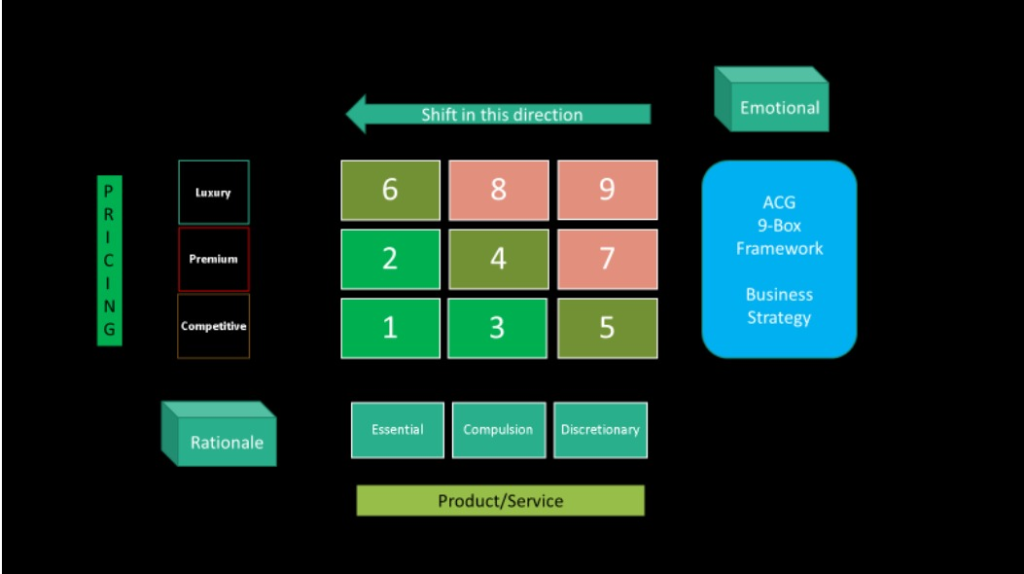During the early part of my corporate career I had read a book written by Dr Spencer Johnson titled “Who moved my cheese?” I am sure many of us have read the book. I strongly believe that all business should seriously ask this question- has this pandemic moved my cheese? Chances are high that it has. At Aidias Consulting Group (ACG) we consult with several family run organizations for their business, marketing, HR, and IT strategies. To serve the interests of our client organizations better, we have created a framework for business strategy which we are calling ACG-9-Box Framework for business strategy. The framework is a simple 3×3 matrix as illustrated below along with the influence of emotion versus rationale on the customers’ purchasing decision of the product/service:

In the above framework, emotional component on purchasing decision increases as the customer buys products/services in box number 9 and is driven more by rationale as the purchasing is closer to box number 1. Any brand of luxury car competes in box number 9 and will continue to do so even after the pandemic. Our experience suggests that luxury cars are bought more to satisfy the emotional need of the customer. Rationale or logic is used to choose the variant within a brand. This is a dynamic framework and the idea is to make product/service shift more towards ‘essential’ to increase customer demand. Literally, the cheese needs to be moved. Has the cheese shifted in the first place? The questions which need to be asked is ‘where was my business before the pandemic?’. Has it shifted due to the pandemic? Let us take a simple example. Hand sanitizer business was in box number 7 before the pandemic. It has rapidly shifted to box number 1 or 2 depending on the pricing strategy of the sanitizer brand. How many FMCG companies have launched brand extensions with sanitizer as the product? Box 1 means severe competition. And box 9 means lesser number of brands even though the degree of competition could be extremely high as the number of customers would be less. Let us use this framework for the automobile industry- 2-wheelers as well as cars. Pre-pandemic it was a discretionary purchase for sure. Has it shifted to compulsion for people to maintain social distance? Definitely, yes. Those who can afford will like to own a vehicle to commute to and from work. Which market is likely to benefit from this ‘compulsion’? The second-hand car/2 wheeler market. This should be a key strategy adopted by automobile companies. There is a logical extension to this possibility. Better ‘exchange’ value of cars which are old can motivate few customers to exchange for new. Clearly the business could be shifting from box 5 or 7 to box 3 or 4. The strategy for marketing, sales, after sales, sales of accessories and financing will be influenced by this shift in the business dynamics to the new box. The ratio of emotion: rationale in purchase decision is likely to be 50-50. Once a business is clear about this customer psychology, sales pitches and training of sales teams can be adjusted accordingly. Does it mean brands featuring in box number 9 have a bleak future post the pandemic? Difficult times, yes. Bleak future? Perhaps, not. It all depends on how such brands appeal to the emotional component of decision making to the prospective customers. Marketing, sales, and CRM strategies will get refined and redefined based on this business framework and how the cheese has shifted. Businesses also need to understand the shift in digital touchpoints of the customers path to purchase; define the experience at each touchpoint; and embark on the journey of digital transformation which will be the greatest impact of this pandemic. We believe that digital transformation is less about technology and more about processes, policies and people and their attitude. Digital transformation begins at the top. Sadly, the understanding of the digital interface of business by the business owners is rather limited and often underestimated. This could be ‘make or break’ for business in A.C- After Corona.

